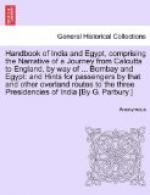* * * * *
As the service proceeds the ranks of the congregation kneel, stand, fall prostrate, and press the brow upon the ground with a rhythm so reverential and so dignified that the watcher forgets for a time the torn or tawdry raiment, the grime of the factory, the dust of the streets, and feels that each fresh attitude of devotion is indeed the true posture of prayer. It is as a sea troubled by the breath of some unseen spirit,—wave upon wave rising, bending, and finally casting itself low in humility and self-sacrifice at the very footstool of the Most High. But all the worshippers are men. “Where are the women,” you ask; “do they not repeat the daily prayers also?” “Verily yes,” replies our guide; “they are all praying in their homes at this hour. More regular, more reverent are they than we are; and if we men but prayed as the women pray, no shadow would dim the brightness of Islam.”
* * * * *
[Illustration: An Arab.]
As the evening-prayer progresses groups of men and women with children in their arms gather at the main entrance of the mosque. For the children are vexed with sickness against which medicine has availed nought, and in a higher healing lies their only chance of recovery. So, as the congregation passes out through the gateway, the parents hold out their ailing children; and well-nigh every worshipper, rich or poor, young or old, turning his face downwards lets his prayer-laden breath pass over the face of the sick child that needs his aid. A picturesque custom is this, which illustrates two ancient and universal beliefs, namely that all disease is spirit-caused and that the holy book is charm-laden. He who repeats the inspired words of the Koran is purged of all evil, and his breath alone, surcharged with the utterances of divinity, has power to cast out the devils of sickness. Thus to this day all classes of Mahomedans, but particularly the lower classes, carry their sick children to the mosques to receive the prayer-laden breath of the Musallis (prayer-sayers): and sometimes in cases of grievous disease a Pir or Mashaikh is asked to perform the healing office, prefacing the brief ceremony with that famous verse of the Koran:—“Wa nunaz-zilo minal Kuraani ma huwa Shifaun wa rah matun lil moaminina” which being interpreted means, “We send down from the Koran that which is a cure and a mercy unto true believers.” So the mosques of the City are homes of healing as well as of prayer.




